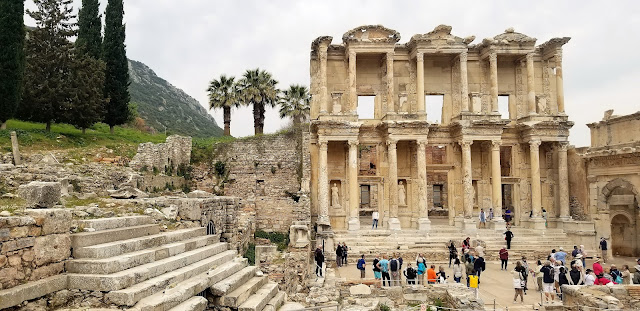April 16, 2022
68 degrees. We'd hoped to return to the Med to find spring, but according to the forecasts, this may be our last warmish day for a while...
And you see and hear that not only in Ephesus but in almost all of Asia this Paul has persuaded and turned away a great many people, saying that gods made with hands are not gods. Acts 19:26
 |
| Spring comes to Ephesus |
 |
| Ready to continue our pilgrimage! |
 |
| Ruins of the shopping area! |
These are the remains of the agora--a sort of first century Walmart--where merchants would make and sell their wares. It was probably here that Demetrius, the influential silversmith, sold his little statues of Artemis to the populace. Paul's preaching so impacted his business that he led a riot that spilled from the agora to the nearby amphitheater where 24,000 incensed people shouted "Great is Artemis of Ephesus!" for two hours! (Acts 19:23-41)
 |
| The library of Celsus, home to over 12,000 scrolls in its heyday. |
 |
| This stray cat is pointing out some first century Christian graffiti. It somehow translates to the same set of letters in the Greek word for fish, which stand for: "Jesus Christ Son of God Savior" |
 |
| Truth in Advertising! |
We climbed back aboard our bus and returned to Kusadasi (pronounced "Koosh-ah-dah-see) which is where the port for Ephesus is now located.
Over many years, the Ephesian harbor silted up and the city was no longer located right on the coast. Don't let anyone fool you. Geography really is destiny. The lack of a harbor meant the end for the great city and it began to atrophy and finally fall into ruin as its great stones were pillaged to use for other building projects. Even the iron clamps that held stones tight together were salvaged.
In Kusadasi, we visited a Turkish rug merchant. They showed us how the silkworm cocoons are boiled to release the strands of silk and turned into incredibly strong and luxurious thread. Kristy was fascinated because she used to have those cocoons in her kindergarten classroom so the kids could watch the worm inside emerge as a butterfly. One of our group asked if the worms are killed in the boiling process.
I tried not to roll my eyes. May not have been entirely successful.
But our Turkish host was kindness itself. He explained that if the insect was allowed to emerge from the cocoon, all the fibers would be broken and no silk could be produced. A single cocoon can be turned into a mile-long strand of thread.
Some rugs are made only with natural dyes, coming from plants, sea creatures, insects, and minerals. Others use manmade dyes. Some aren't made exclusively from silk, using sturdier wool and cotton instead. But they are all hand-knotted and all beautiful!
The rugs were beautifully presented, large ones slapped down with two men carrying them in, smaller ones tossed in a swirl that made them seem like actual flying carpets! The nap of the rug means the colors change from light to dark, depending on which way they are laid down on the floor. Oh, my! I was sorely tempted by them, but managed to exit the building without buying one.
But only just...
CORRECTION!
The apostle Paul did NOT meet Priscilla and Aquilla in Ephesus. They were in Corinth. His companions in Ephesus were Gaius and Aristarchus, who were seized by the mob and rushed into the great amphitheater. Paul wanted to join them, but he was urged by some of the officials of Ephesus, who were friends of Paul's, not to venture out into the theater because of the riot. All turned out well in the end and without Paul's presence to further stoke Demetrius' fire, the people gave up their protest.





No comments:
Post a Comment
I'd love to hear from you. Leave a comment and let's chat!